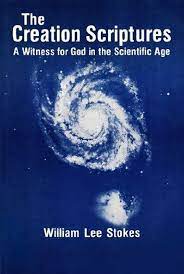Articles/Essays – Volume 16, No. 2
Creative Speculation on the Creation | William Lee Stokes, The Creation Scriptures: A Witness for God in the Scientific Age
Whether or not one agrees with all of the ideas presented by William Lee Stokes, it is not possible to read his little book The Creation Scriptures without being stimulated, entertained, and enlightened. Its bite-sized chapters make for easy reading and easy reference, and his writing is lucid.
Starting from the premise that the scriptures are literally the word of God, Stokes proceeds to accommodate them within the tenets of modern scientific discovery. In so doing he has come forth with some intriguing, even novel explanations. In considering the creation process as described in scripture in cosmic rather than earthbound perspective, he presents some satisfying interpretations of scriptures which (otherwise might read as nonsense. Particularly intriguing is his explanation of the meaning of Moses 2:2 in which “God caused darkness to come up upon the face of the deep” before he caused light to ap pear. According to Stokes and others from whom he quotes, a relatively brief period of total darkness may have occurred after the initial energy from the Big Bang had become dissipated and before gravity drew together the dispersed matter into light generating bodies. Also novel is his description of heaven as the firmament, its relationship to the waters above and below and its physical location in our galaxy. He considers heaven as the center of our spiral shaped galaxy, the waters under the firmament and the waters above the firmament referring to the two major arms of the spiral.
Most readers, however, will find some of his logic seriously defective. Several speculations are elaborately introduced and weakly defended. This is particularly true of the supposed origin of life in space rather than on earth, his explanation of how life could appear on earth before the creation of the sun, the generic treatment of night and day versus the specific periods during the remainder of creation, and the removal of the initial Big Bang period from the scriptural account. Among his weakest arguments are those which address biological phenomena. He erroneously assumes that seeds of plants cannot germinate in the light, when in fact, seeds of many species are unable to germinate without light. He also suggests that chloroplasts may have been present in interstellar plant life, an absurd postulate because of the inordinate complexity of chloroplasts and their inter dependence upon nuclei and other cellular organelles.
Excessive stretching to accommodate a literal scriptural interpretation is common. For example, he says, “Accepting for the moment the thought that these scriptures, like the creation account of Genesis, are deliberately vague, incomplete, and cryptic but still basically true, I take the position that they contain enough advanced information to prove that their source was the Creator himself. The task of full interpretation lies in the future,” and “The seeming illogic of the Genesis story in having plant life appear before the creation of the sun may not be illogical after all. The Genesis order could well be essentially correct, another proof for a divine origin of the scriptures.” Such hedging sounds weak.
Because the essay is specifically ad dressed to an LDS audience, it is unfortunate that the publishers who deal with LDS books were unwilling to print it. Not only would it have become more visible and available to those for whom it was written, but also it would have been greatly improved by careful editing. An editor could have removed the numerous, annoying typographical errors and the several incidents of redundancy. Despite its weak nesses, however, it is a delightful stimulating contribution that deserves to be read.
The Creation Scriptures: A Witness for God in the Scientific Age by William Lee Stokes (Salt Lake City: Starstone Publishing, 1979), 204 pp., $5.95.


 Back to full Issue
Back to full Issue

